|
 |
 |
Radon-Specific Publications and Resources
|
Additional Indoor Air Quality resources on Asthma, Secondhand Smoke, Schools,
Large Buildings and Homes can be found at our
Indoor Air Publications site. If you have further questions about Radon, please call your
State or Regional Radon Contact or the National Radon Information Line at:
1-800-SOS-RADON
[1 (800) 767-7236]
For information on how to order publications from EPA -
click here.
|
|
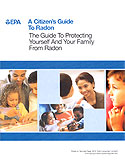 |
A
Citizen's Guide to Radon The guide to
protecting yourself and your family from radon.
This recently revised guidance offers strategies for testing
your home for radon and discussions of
what steps to take after you have tested, discussions of the risk of
radon and radon myths.
[EPA 402-K02-006, Revised May
2004]
An Adobe Acrobat pdf version of the Guide is
available citizensguide.pdf
(4.36MB file).
 |
Este folleto es la versión en español de
la popular guía “ Guía para……” fue desarrollado por la Coalición
Nacional de Organizaciones Hispanas de Servicios (COSSMHO) para la Agencia
para la Protección Ambiental de los Estados Unidos. Llame a su oficina estatal de Radón para obtener una
copia de esta guía (todas las oficinas estatales de Radón están disponibles
para contestar sus llamadas y preguntas en inglés). Documento de la agencia [EPA
número 402-K-93-005, septiembre de 1993]
|
|
|
 |
This booklet is intended for anyone who is buying or selling a home,
real estate and relocation professionals, home inspectors and others.
If you're interested in printing
this booklet, call (202) 343-9427 for more information on how to obtain a
free CD-Rom (Adobe PageMaker 6.5 for Windows version of the
Guide).
[EPA 402-K-00-008, July 2000]
An Adobe Acrobat pdf version of the Guide is available
hmbuygud.pdf (1,789KB
file size).
 |
El presente folleto está destinado a toda persona que esté en proceso
de comprar o vender una vivienda, a los profesionales de bienes raíces y
traslados, a los inspectores de viviendas y a otras personas. Vaya a la
Sección 8.c.1, en este supervínculo, para conseguir información sobre como
obtener uno o varios ejemplares de esta Guía. Si está interesado en imprimir este folleto, llame al (202)
343-9427 donde obtendrá más información sobre cómo obtener un CD.Rom (Adobe
PageMaker 6.5 para Windows). Este es el número de documento de [EPA
402-K-02-001, julio de 2002]
Además, puede obtenerse aquí una
versión en Adobe Acrobat pdf de la Guía:
hmbuyguidsp.pdf (dimensión del archivo 620K)
|
|
|
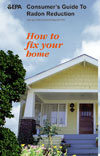 |
You have tested your home for radon, but now what? This recently
revised booklet is for people who have tested their home for radon and confirmed that they have elevated radon levels -- 4 picoCuries per liter (pCi/L) or higher. This booklet can help you: Select a qualified contractor to reduce the radon levels in your home, Determine an appropriate radon reduction method,
and Maintain your radon reduction system.
[EPA
402-K-03-002, Revised February 2003]
An Adobe Acrobat pdf version of the Guide is available consguid.pdf
(572KB file).
|
Breathing Easy: What Home Buyers and Sellers Should Know About Radon

The video satisfies a long-standing need for a short visual educational tool on how to
best include radon in residential real estate transactions. With a bit of light humor, the video covers the basics, including radon science, the lung cancer risk, home inspection, building a new home
radon-resistant, testing and fixing a home, disclosure, state radon offices, hotline and web resources, and key radon numbers, e.g., EPA's action level
and the U.S. indoor and outdoor averages.
The primary audiences are home buyers and sellers, and real estate sales agents and brokers. Home inspectors, mortgage lenders, other real estate
practitioners, and radon services providers will also find the video helpful. Single copies of the video are free from IAQ-Info (1-800-438-4318) in VHS,
CD and DVD formats
[ask for (EPA 402-V-02-003) (TRT 13.10)].
|
National Radon Results - 1985-2003 (updated version of 1985-1999 report)
Since radon’s advent as a National health concern in the mid-1980s, the United States has made significant progress in reducing the risk from radon.
This progress is the result of a long-term effort between EPA, citizens, non-profit organizations, state and local governments, the business community,
and other Federal agencies working together. Since 1985, millions of homes have been tested for radon, and an estimated 800,000 homes have been mitigated. In addition, approximately 1.2 million
new homes have been built with radon-resistant features since 1990. EPA will continue to focus its risk reduction on mitigating existing homes and building new
homes radon-resistant. As a result of these actions through 2003, EPA estimates that as many as 650 future lung cancer deaths are prevented (lives saved) each year.
*The National Radon Results: 1985 to 1999 report has been updated to reflect more recent data through 2003. A full update to the report,
now called Progress in Reducing the Risk From Radon in America’s Homes has been drafted and will be posted here when completed. Download the Adobe Acrobat PDF version of the report natl_radon_results_update.pdf
(a 200KB file).
|
|
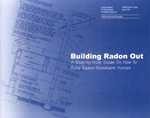 |
This 81-page, fully illustrated guide contains all the info you need in one
place to educate home builders about radon-resistant new construction (RRNC), including: Basic questions and detailed
answers about radon and RRNC; Specific planning steps before installing a system;
Detailed installation instructions with helpful illustrations; Tips and tricks when installing a
system, Marketing know-how when dealing with homebuyers; and, Architectural drawings. This document is
available here as a 8.3 MB Adobe Acrobat PDF file (buildradonout.pdf)
[EPA 402-K-01-002, April 2001]
|
|
 |
This document is intended to serve as a
model for use by the Model Code Organizations, States and other
jurisdictions as they develop and adopt building codes, appendices to
codes, or standards specifically applicable to their unique local or
regional radon control requirements.
[EPA 402-R-94-009,
March 1994]
|
|
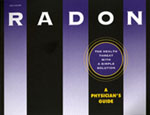 |
This booklet on radon has been developed for
physicians by the EPA in consultation with the American Medical
Association (AMA). Its purpose is to enlist physicians in the
national effort to inform the American public about the serious health
risk posed by indoor radon gas.
[EPA 402-K-93-008,
September 1993]
|
|
 |
This guide, created by the Environmental
Law Institute (ELI) with EPA's review, is for people who rent their
apartments or houses. The guide explains what radon is, and how to find
out if there is a radon problem in your home. The guide also talks about
what you can do if there are high radon levels in your home.
[EPA
Document Number 402-K-98-004]
|
|
 |
It is important that students, teachers and
parents be aware that a potential radon problem could exist in their
school.
[EPA 402-F-94-009, October 1994]
|
|
 |
The purpose of the Radon Mitigation
Standards is to provide radon mitigation contractors with uniform
standards that will ensure quality and effectiveness in the design,
installation, and evaluation of radon mitigation systems in detached and
attached residential buildings three stories or less in height. These
standards are intended to serve as a model set of requirements that can
be adopted or modified by state and local jurisdictions to fulfill
objectives of their specific radon contractor certification or licensure
programs.
[EPA 402-R-93-078, October 1993 (Revised
April 1994)]
EPA Incorporates ASTMI E2121 By Reference
EPA has incorporated E2121 by reference and retained EPA’s
Radon Mitigation
Standards (RMS) in effect until at least 2006. This decision is
consistent with the Office of Management and Budget (OMB) Circular A-119
on Federal participation in the development and use of voluntary consensus
standards, and the National Technology Transfer and Advancement Act (NTTAA)
of 1995. The policy discussion and response to comments paper is
available here as a PDF file (final_e2121policy.pdf
- 180KB file size).
If you have questions concerning this policy, contact either Philip
Jalbert (jalbert.philip@epa.gov) or Eugene Fisher
(fisher.eugene@epa.gov).
You can also contact Diane Hamilton 202-343-9427 or via e-mail at
hamilton.diane@epa.gov for
copies of E2121.
|
|

|
This introductory brochure provides basic
information on radon-resistant construction in new homes and directs the
reader to more detailed information.
[EPA 402-F-98-008,
April 1998]
|
|
 |
This brochure is designed for consumers who
are purchasing newly constructed homes and are curious about
radon-resistant features, builders who construct homes with
radon-resistant features, and real estate professionals who are selling
homes which have radon-resistant features. It can be used as a marketing
tool for the home building industry.
[EPA 402F-98-001,
September 1998]
|
|
 |
Radon
Prevention in the Design and Construction of Schools and Other Large
Buildings.
It is typically easier and much less
expensive to design and construct a new building with radon-resistant
and/or easy-to-mitigate features, than to add these features after the
building is completed and occupied.
[EPA 625-R-92-016,
June 1994]
Copies can be ordered from the Indoor Air Quality (IAQ) Information
Clearinghouse at 1-800-438-4318.
This document is available in PDF format from EPA's
Office of Research and Development.
|
|
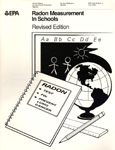 |
Radon
Measurement in Schools
(Revised Edition)
This report has been prepared to provide
school administrators and facilities managers with instructions on how
to test for the presence of radon. The findings from EPA's
comprehensive studies of radon measurements in schools have been
incorporated into these recommendations. This report supersedes Radon
Measurements in Schools - An Interim Report (EPA 520/1-89-010).
[EPA
402-R-92-014, July 1993] Copies can be ordered from the Indoor
Air Quality (IAQ) Information Clearinghouse at 1-800-438-4318.
|
|
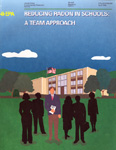 |
Reducing
Radon in Schools: A Team Approach.
This document will assist you in determining
the best way to reduce elevated radon levels found in a school. It is
designed to guide you through the process of confirming a radon problem,
selecting the best mitigation strategy, and directing the efforts of a
multidisciplinary team assembled to address elevated radon levels in a
way that will contribute to the improvement of the overall indoor air
quality of the school.
[EPA 402-R-94-008, April
1994] Copies can be ordered from the Indoor Air Quality (IAQ)
Information Clearinghouse at 1-800-438-4318.
|
|
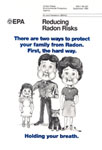 |
[EPA 520/1-89-027A,
September 1992]
|
|
 |
Technical Support Document
for the 1992 Citizen's Guide to Radon
This document presents the wide range of
technical analyses, radon risk communication research, legislative
directives, and other information that the U.S. EPA used to shape the
policies that are set forth in the 1992 "A Citizen's Guide to
Radon." The document summarizes extensive technical analyses of the
data that have been gathered over the past years.
[EPA
400-R-92-011, May 1992] Copies can be ordered from the Indoor
Air Quality (IAQ) Information Clearinghouse at 1-800-438-4318.
|
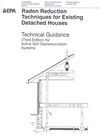 |
Radon Reduction Techniques for Existing Detached Houses:
Technical Guidance (Third Edition) for Active Soil Depressurization Systems
This technical guidance document has been prepared to serve as a
comprehensive aid in the detailed selection, design, installation, and
operation of indoor radon reduction measures for existing houses based on
active soil depressurization techniques. It is intended for use by radon
mitigation contractors, building contractors, concerned homeowners, state and
local officials and other interested persons. Office of Research and
Development
[EPA 625/R-93-011, October 1993] Copies can be ordered from the
Indoor Air Quality (IAQ) Information Clearinghouse at 1-800-438-4318.
|
|
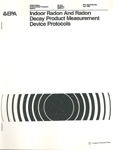 |
The objective of this document is to provide
information, recommendations, and technological guidance for anyone
providing measurement services using 15 radon and radon decay product
measurement methods. These protocols provide method-specific
technological guidance that can be used as the basis for standard
operating procedures.
[EPA 402-R-92-004, July
1992]
|
|
 |
This document presents the U.S. EPA's
technical guidance for measuring radon concentrations in residences. It
contains protocols for measuring radon for the purpose of deciding on
the need for remedial action, as presented in the 1992
Citizen's
Guide to Radon, and in the
Home
Buyer's and Seller's Guide to Radon.
[EPA 402-R-93-003,
June 1993]
|
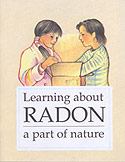 |
Learning About Radon A Part Of Nature
Written for Native Americans, this 18-page booklet discusses radon's place in the world, the basics on testing,
and how homes can be fixed to reduce radon levels. Native Americans should contact their Tribal health department
or state radon program office for more information.
[EPA 402-K-02-002, February 2002] Copies can
be ordered from the Indoor Air Quality (IAQ) Information Clearinghouse at 1-800-438-4318.
|
IAQ INFO
P.O. Box 37133, Washington, DC 20013-7133
1-800-438-4318/703-356-4020
(fax) 703-356-5386
iaqinfo@aol.com
or, you can order these publications
directly via EPA's National Service Center for Environmental
Publications (NSCEP) (http://www.epa.gov/ncepihom/).
web site. Your publication requests can also be mailed, called or faxed
directly to:
U.S. Environmental Protection Agency
National
Center for Environmental Publications (NSCEP)
P.O. Box 42419
Cincinnati, OH 42419
1-800-490-9198/(513) 489-8695 (fax)
Go to top
|
|

